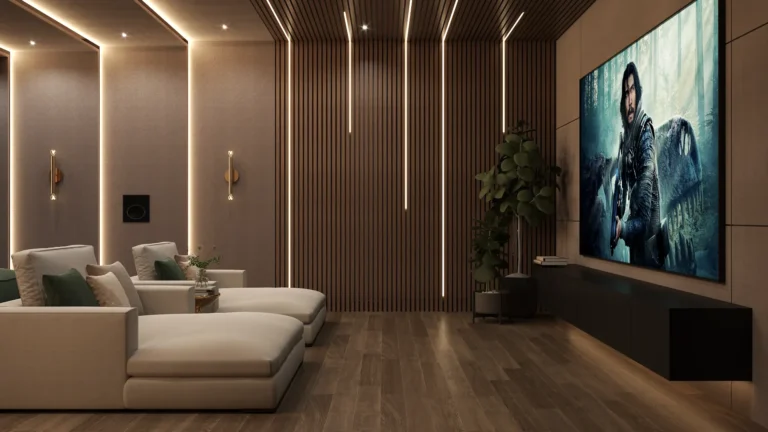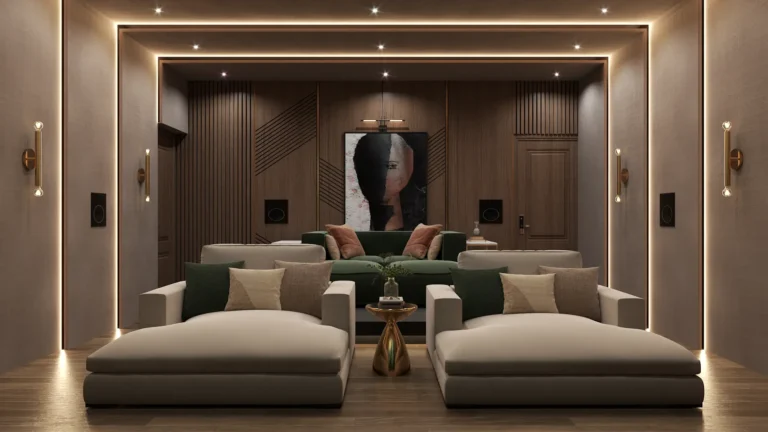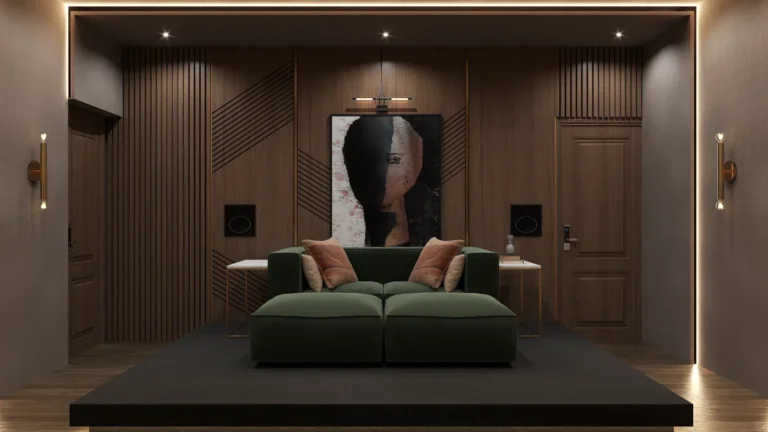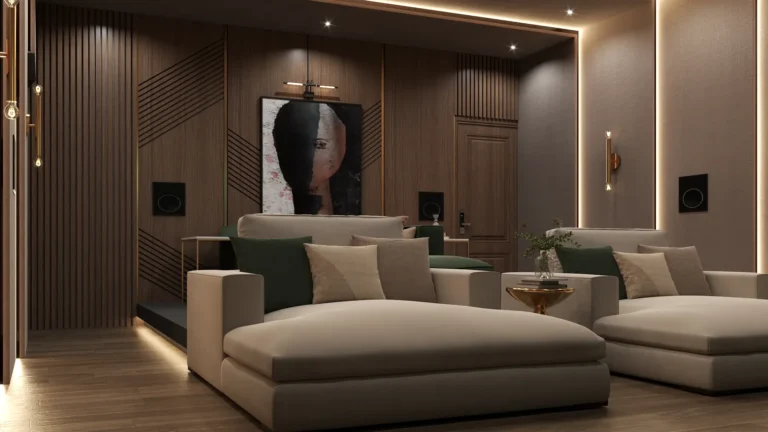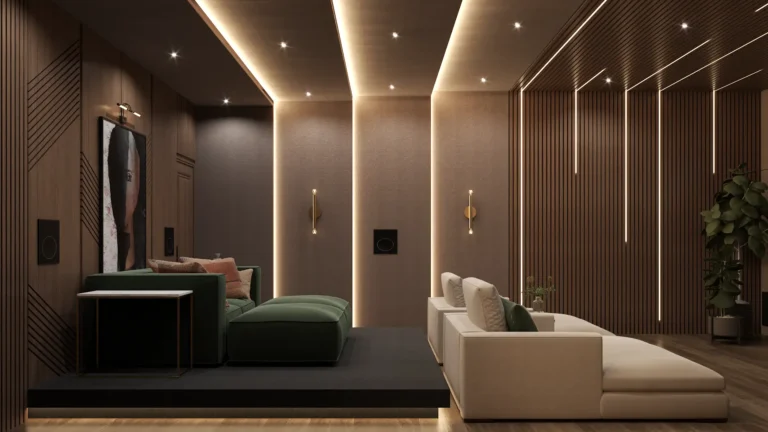Creating a home theater involves much more than just setting up a screen and speakers. It’s about crafting a space that combines cutting-edge technology, thoughtful design, and an immersive atmosphere. The examples shared here highlight how to blend comfort and elegance to create a truly luxurious entertainment room. With the right planning and inspiration, you can transform your home into the perfect venue for family movie nights, gaming marathons, or private screenings. Let’s dive into the key elements to help you design the ultimate home theater.
1. Planning the Space: Layout is Everything
The foundation of a great home theater starts with a well thought out layout. A carefully planned design ensures that every element, from seating to pathways, feels intentional and functional.
Optimizing the Space
Tiered seating—where each row is slightly elevated—ensures that everyone has a clear view of the screen. For smaller or uniquely shaped rooms, modular risers that can be adjusted or stacked offer maximum flexibility. This approach not only enhances viewing angles but also adds a professional theater-like aesthetic to the room. If space is limited, consider modular furniture that’s easy to rearrange, allowing the room to serve multiple purposes.
Maintaining Clear Pathways
Open pathways are essential to a functional and inviting design. By avoiding clutter and ensuring ample room to move, you’ll create a space that feels organized and balanced. Clear pathways also enhance the visual flow, making the room feel more spacious and polished.
2. Setting the Right Mood with Lighting
Focused lighting near seating areas, such as on side tables, ensures practicality while complementing the theater’s ambiance. These lights can be carefully positioned to highlight essential areas, avoiding unnecessary glare and ensuring a seamless visual experience. Adjustable task lighting is ideal for a variety of activities, including grabbing snacks, reading, or managing remote controls, offering both convenience and functionality. By incorporating dimmable options, you can tailor the brightness to match different viewing scenarios, preserving the cinematic atmosphere.
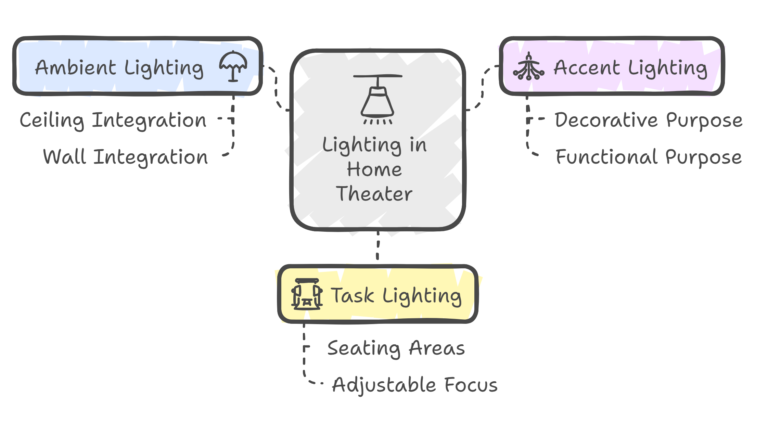
Ambient Lighting
Soft LED strip lights integrated into the ceiling or walls provide a diffused glow that enhances the room’s depth. This indirect lighting minimizes glare on the screen while adding a sense of coziness and sophistication. It’s perfect for maintaining a cinematic vibe.
Accent Lighting
Wall sconces with metallic finishes, like gold or brass, add elegance and warmth to the room. These accent lights serve both decorative and functional purposes, tying the design together while creating an inviting atmosphere. Unique fixtures can also add personality to the space.
Task Lighting
Focused lighting near seating areas, such as on side tables, ensures practicality without disrupting the theater’s ambiance. Adjustable task lighting is ideal for small tasks like grabbing snacks or adjusting settings while keeping the cinematic feel intact.
Additionally, integrating smart lighting controls allows for effortless customization, enabling you to switch smoothly between tasks and relaxation modes. These thoughtful enhancements not only improve usability but also elevate the overall luxury and versatility of the space, ensuring that it meets the highest standards of both form and function.
3. Choosing Comfortable and Stylish Seating
Seating is the heart of your home theater. Prioritizing comfort while incorporating stylish elements ensures that everyone enjoys the experience.
Versatile Seating Options
Combine lounge chairs, sectional sofas, and recliners to accommodate different needs. Features like built-in cup holders, USB ports, and adjustable headrests can elevate the experience. Recliners with massage functions or heated seats add an extra layer of luxury. For larger gatherings, modular seating maximizes space while maintaining comfort.
Harmonizing Colors and Textures
Neutral tones like beige, green, and brown create a timeless base. Incorporate throw pillows with various textures to add warmth and depth. Materials like velvet and woven fabrics can be chosen to complement the room’s overall color palette, ensuring a cohesive and inviting aesthetic.
4. Enhancing Walls for Function and Aesthetics
The walls in a home theater are more than just a backdrop—they contribute to both the room’s acoustics and its visual appeal.
Acoustic Enhancements
Slatted wood panels or fabric-covered acoustic panels improve sound clarity by reducing echoes and reverberation. These treatments ensure a premium audio experience while adding texture and interest to the walls. For a modern touch, consider combining acoustic functionality with bold design elements like patterned or 3D panels.
Incorporating Artwork
Strategically placed artwork can personalize the space without overpowering it. Abstract or themed pieces, like those behind the seating in this design, create focal points that enhance the room’s character while blending with its purpose.
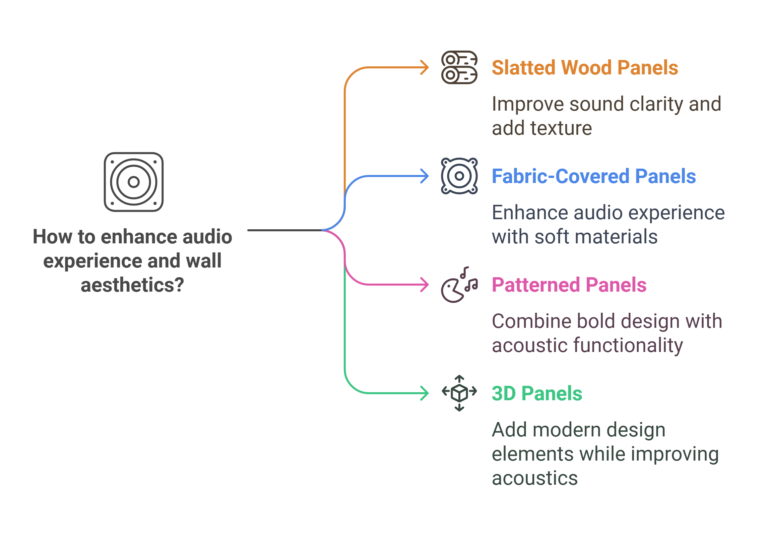
5. Flooring: The Unsung Hero of Theater Design
Flooring choices significantly impact the comfort and acoustics of your home theater. Don’t underestimate the importance of selecting the right materials.
Balancing Style and Function
Hardwood or laminate floors are durable and elegant, while plush area rugs under seating add warmth and improve sound absorption. High-pile rugs can enhance the luxurious feel, tying the room together both visually and acoustically.
6. The Screen Wall: A Design and Technology Masterpiece
The screen wall is the focal point of any home theater, and its design should seamlessly integrate technology with aesthetics.
Framing the Screen
Wooden slats or textured panels surrounding the screen add depth and sophistication. This framing technique draws attention to the screen while integrating it with the room’s overall design. Adding subtle backlighting around the frame can amplify the dramatic effect, creating an immersive focal point.
Integrating Technology
Keep cables and equipment neatly hidden to maintain a clean, streamlined look. Built-in cabinets or smart storage solutions are perfect for housing tech essentials. Consider incorporating smart home systems for seamless control of lighting, sound, and screen settings, enhancing both functionality and wow-factor.
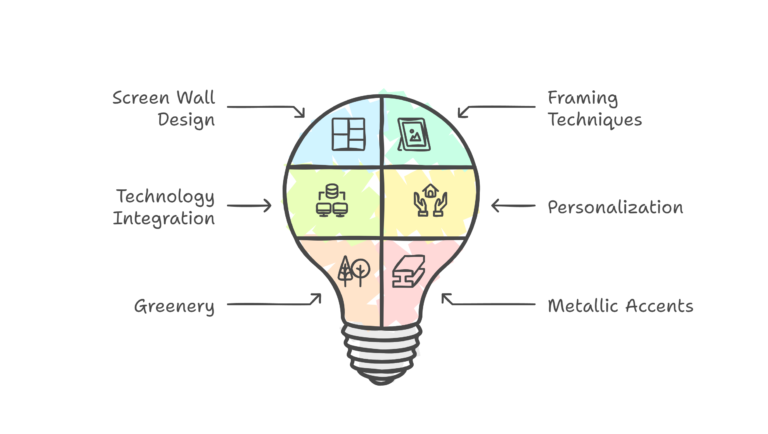
7. Adding Personalized Touches to Your Theater
Personalization transforms a good design into an unforgettable space. Adding elements that reflect your personality and preferences makes your home theater truly unique.
Bringing in Greenery
Plants soften the room’s lines and balance its tech-focused elements. Even a small potted plant can add life and warmth, enhancing the overall ambiance.
Subtle Metallic Accents
Incorporating metallic details, like gold or chrome finishes, introduces a touch of sophistication. When used sparingly, these accents elevate the room’s design without overwhelming it. Mixing metals can also create a dynamic, modern aesthetic.
Final Thoughts: Your Home Theater, Your Vision
A well designed home theater is about more than just watching movies. It’s about creating a versatile space where memories are made, whether through gaming, karaoke nights, or virtual meetings. Every detail, from the seating to the lighting, plays a role in crafting a room that’s as functional as it is beautiful.
Are you ready to bring your dream home theater to life? With thoughtful design and expert planning, you can create a space that’s tailored to your lifestyle and preferences. Let’s get started!
Frequently Asked Questions
What considerations should I take into account for soundproofing a home theater?
Soundproofing is essential to prevent noise from leaking out and to enhance the listening experience inside. Techniques include using double drywall, acoustic insulation, and soundproof doors, as well as installing carpets and heavy curtains to dampen sound.
How do I choose the right projector and screen for my home theater?
Consider the size of your room, viewing distance, and lighting conditions. Short throw projectors are ideal for smaller spaces, while a fixed frame screen offers better image quality and durability. Look for a screen with the right gain and aspect ratio for your projector.
What ventilation options work best for a home theater?
A home theater needs proper ventilation to prevent equipment from overheating and to maintain a comfortable environment. Quiet HVAC systems, inline duct fans, and well-placed vents ensure effective air circulation without adding noise.
What role does furniture placement play in optimizing the viewing experience?
The placement of furniture impacts sightlines and acoustics. Ensure all seats have a clear view of the screen and are positioned within the optimal audio sweet spot. Use symmetrical arrangements to maintain balance and enhance sound distribution.
How can I future-proof my home theater for evolving technology?
Invest in high-quality wiring and consider conduit systems for easy cable upgrades. Use modular components that can be replaced or upgraded independently. Smart home integration with voice and app controls also ensures compatibility with new technology trends.


